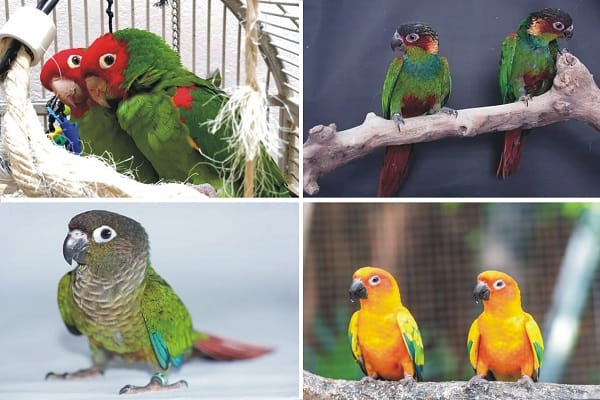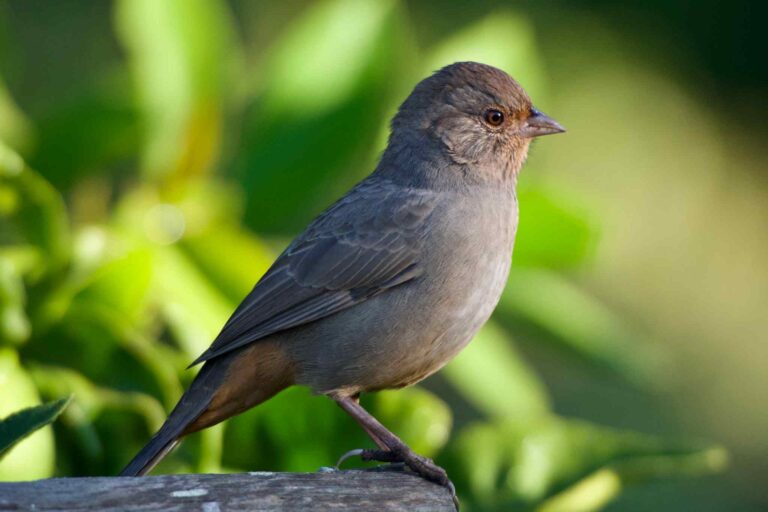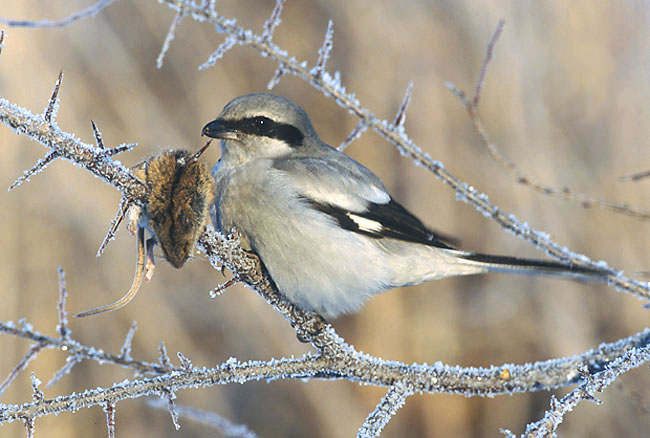10 Amazing Birds With Webbed Feet (With Photos)
Do you wonder why some birds swim and dive so well with their webbed feet? This adaptation helps them live and thrive in water. From beautiful swans to fun-loving penguins, webbed feet birds are truly fascinating. This piece will introduce you to 10 incredible birds. Each has its special features for living in water.
Birds are unique because they have feathers. Their feathers are built from the same stuff as our hair and nails. What makes webbed feet birds stand out is their amazing water skills. The skin between their toes lets them move well in the water. This helps them catch food and avoid enemies. These birds vary a lot in size, looks, and places they live. From grand swans to lively penguins, each one is nature’s work of art.
Introduction to Webbed Feet Birds
Webbed feet birds are birds that spend a lot of time in and around water. They have feet that are perfect for swimming. The skin between their toes helps them move through water easily. They can swim well, dive deep, and also fly. This makes them great at finding food and staying safe.
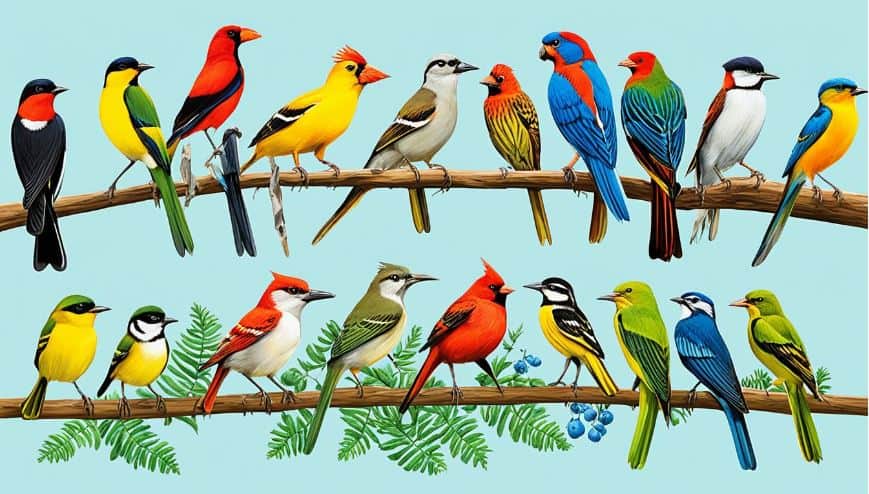
What are Webbed Feet Birds?
Webbed feet birds are a special group of birds. They are made for the water. Their unique feet help them in many ways. They can swim smoothly and quickly. This is important for finding food and escaping from danger.
Importance of Webbed Feet for Water Birds
For water birds, their webbed feet are a vital tool. The webbing lets them float easily. It also helps them move fast in the water. This is key for their survival. It makes hunting easier and helps them get away from predators.
| Webbed Feet Bird Type | Webbing Description | Habitat |
|---|---|---|
| Palmate | Front three toes joined by webbing | Freshwater lakes and rivers |
| Totipalmate | All four toes webbed | Coastal regions and open oceans |
| Semipalmate | Partial webbing between toes | Shallow wetlands and mudflats |
| Lobate | Lobes or flaps aiding swimming | Lakes and ponds |
It’s important to protect birds with webbed feet. They face many dangers, like losing their homes. Preserving their habitats helps keep them safe.
Some reptiles and amphibians also have webbed feet, using them for swimming quickly through water. Crocodiles and alligators possess webbed back feet, while certain turtles have webbed feet for swimming, and aquatic frogs have webbed feet, though tree frogs living on land lack this adaptation. Mammals with webbed feet include platypuses, kangaroos, beavers, muskrats, otters, tapirs, and moles, with platypuses using their front webbed feet to swim underwater and the unique ability to retract the webbing when on land to facilitate running and digging with their toenails.
Ducks – Graceful Swimmers with Webbed Feet
Ducks are part of the waterfowl bird group, in the Anatidae family. They’re smaller than swans but just as graceful in the water, thanks to their webbed feet. These birds come in all sorts of colors, shapes, and sizes. You can find them in ponds, lakes, and even urban areas.
They use their webbed feet to swim well in places like lakes and rivers. Most wild ducks weigh between 2 to 4 pounds. Some are even smaller, weighing less than 1 pound. Ducks have no nerve endings in their feet. This means they don’t mind cold or hot water.

Ducklings hatch about three to four weeks after the eggs are laid. They start running, swimming, and finding their own food within 3 days. After about a month, they have most of their feathers. And in 5 to 8 weeks, they learn to fly. Sometimes, a mom duck can have up to 25 ducklings. This might happen when they join another mom’s group.
Species like Mallards, Blue-Winged Teal, Pintails, and more have stunning feather patterns. Ducks molt, which means they lose their old feathers to grow new ones. They often fly in a “V” shape or in a line.
Divers like the Eider, Canvasback, and Goldeneye have special bills for fishing. Ducks are great at digesting food like plants, bugs, and small fish. They have special air sacs to help keep them floating in water.
Ducks reproduce by transferring sperm during mating. This sperm fertilizes the eggs. Knowing about duck anatomy helps in their conservation. It makes caring for their health and habitats better.
Majestic Geese – Masters of Land and Water
The goose is a bird with webbed feet that people started taking care of over 4,000 years ago. Geese are big with long necks and they make a loud, unique noise. They rule both the ground and water because of their special feet. These allow them to swim well and walk elegantly.
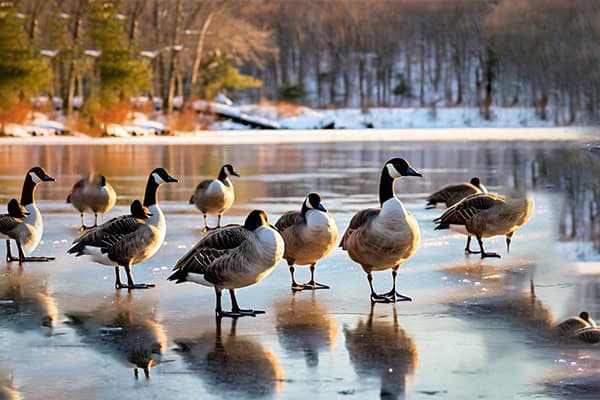
Types of Geese with Webbed Feet
You can find different types of geese with webbed feet in many places like fields and by water. Some kinds are the Snow Goose, Tundra Swan, and Canada Goose. Each is special in its own way.
Behavior and Habitats of Geese
Snow Geese are most active from December to February. This is the best time to see them. They eat in fields and can stay there a long time. But they might leave quickly if the weather changes. In the late afternoon, many Tundra Swans are seen feeding in corn fields. Snow Geese like these fields too. They often gather there to feed and their groups keep moving, making it tricky to know where they’ll be.
Many Snow Geese were seen above fields, then landing and eating. One had a neck collar with the code TC84, showing it was tagged in Canada on August 15, 2011. Soon, Snow Geese will leave their winter homes to go where they breed.
Young Black Bears can climb trees with their long, curved claws. Then, they come down carefully, looking around. Tundra Swans make many sounds in the air, like soft honking and whistles. Efforts in North Carolina protect a home for many Tundra Swans in the winter, saving a big part of their group.
Webbed Feet Birds
Webbed feet are a special trait many birds share. They help birds live well in watery places. These feet make it easy to move through the water. They keep the birds floating, moving, and turning smoothly.
Evolutionary Adaptation for Swimming
Many types of animals, including birds, have independently developed webbed feet. This has happened several times over history. The shape of these feet, along with their webbing, is very helpful. It increases the feet’s size and uses a special design to push against water better.
This special design helps birds as they swim. It lets them move water more with each step, propelling them forward.
Diversity of Webbed Feet Bird Species
There are many bird types with webbed feet, not just the commonly known ducks, geese, and swans. From loons to penguins, each bird is different and lives in various places.
This shows that over time, webbed feet appeared in many types of animals. It’s not just birds, but also frogs, turtles, and even some mammals like beavers.
Birds with webbed feet may have various foot structures. This includes different kinds of webbing and shapes. They live in many places, from lakes to oceans. Unfortunately, the homes of these birds are facing big problems. Issues like losing their habitat, pollution, and climate change are tough for them.
Swans – Elegant Beauties with Webbed Feet
Swans are big, beautiful birds that love the water. They have a slim neck and webbed feet to help them swim. Trumpeter Swans weigh about twenty-five pounds. Trumpeter Swans mainly breed in southeast Alaska and northeast British Columbia. Tundra Swans, their cousins, breed even further north, like in the tundra. If you want to see Tundra and Trumpeter Swans in North America, go to Western Washington in winter.

Types of Swans Found Worldwide
Swans come in several types found all over the world. Each type has its own special features and homes. Trumpeter Swans are related to Tundra Swans, and the most the author saw at once was fourteen. Mute swans, another kind, can have huge wings and weigh about 30 pounds. They need lots of water to take off, about 30 feet wide. Mute swans eat a lot of plants, and in the US, egg addling is used to control their numbers. This means they remove and destroy the eggs. The Queen of England owns some swans on the River Thames. Mute swans stay in one area most of the time, but they can move to different water types. In some parts of the US, they cause problems for native wildlife by changing the habitats with their eating.
Seagulls – Seafaring Birds with Webbed Feet
Seagulls are birds living near coastlines, like oceans, lakes, and rivers. They’re known for their webbed feet, helping them swim and navigate through water with ease. Plus, seagulls are crucial for the ecosystem, keeping it in balance by eating various marine life.
Adaptations for Coastal Living
These birds have special features for thriving in coastal areas. Their webbed feet and streamlined bodies make them great at swimming and flying. They can even drink saltwater, thanks to their unique salt glands. This allows them to live in the sea.
Importance in Marine Ecosystems
Seagulls are key players in the marine environment. They help keep water habitats healthy by eating various sea creatures and even dead animals. Their droppings, called guano, enrich the land, supporting a variety of life, including coral reefs.
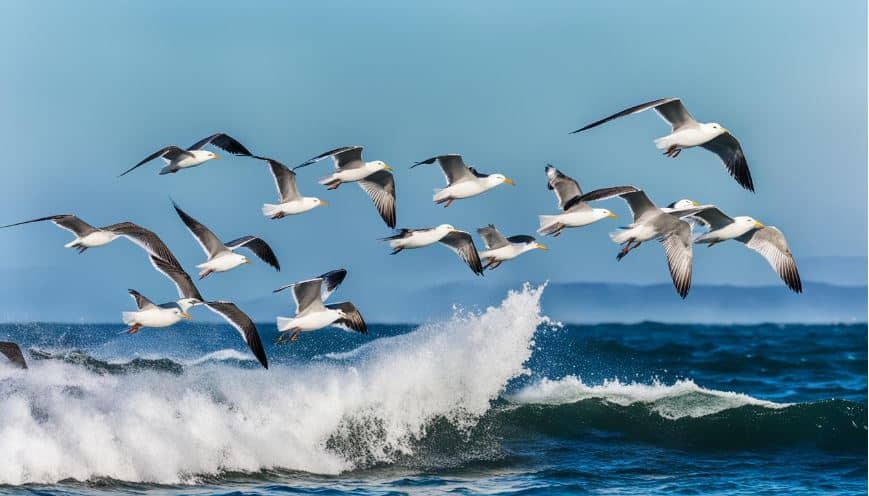
Avocets – Unique Wading Birds with Webbed Feet
Avocets are a unique group of wading birds known for their distinctive upturned bills and webbed feet. They thrive in shallow, coastal waters, using their bills to feed on small water creatures. Their webbed feet help them move through water easily, making them great hunters and gatherers in their underwater homes.
Avocets have a bold black-and-white look with a rusty head and neck when it’s breeding time. As for nonbreeding avocets, their heads turn grayish white. You’ll also see a black patch when they’re flying. They find food by sweeping their bills from side to side in shallow waters. They can also stand on one leg, keeping their bill tucked away. These birds are known for wading as they look for food, but they can swim too.
The American avocet is about 41 to 51 cm (16.4 to 20.4 in.) long and weighs 300 to 420 g (11 to 15 oz.). They hatch their eggs in 22 to 24 days. A typical brood has 3 to 5 eggs. They become adults around one year of age and usually live for about 5 years.
The number of American avocets with adult plumage is at least 10,000. The IUCN has labeled them “Least Concern” because of their large, stable group and interconnected habitats. Avocets live in a variety of places including mudflats, salty lakes, and wetlands of freshwater and salt.
Besides their looks, avocets have some cool habits. Their young leave the nest in just one day. As they grow, they start looking more like adults and their bills become straighter. Male avocets have straighter bills than females. They like to breed in shallow waters. These birds eat by sweeping their bills or by poking into the water. They catch tiny water creatures this way.
Clearly, avocets are interesting wading birds. They are perfectly designed to live and find food in all kinds of wet places. Thanks to their webbed feet and feeding style, they’re truly remarkable creatures of the water.
Flamingos – Vibrant Waders with Webbed Feet
Flamingos catch the eye with their bright colors and unique beaks. They live near salty lakes and lagoons all over the world.
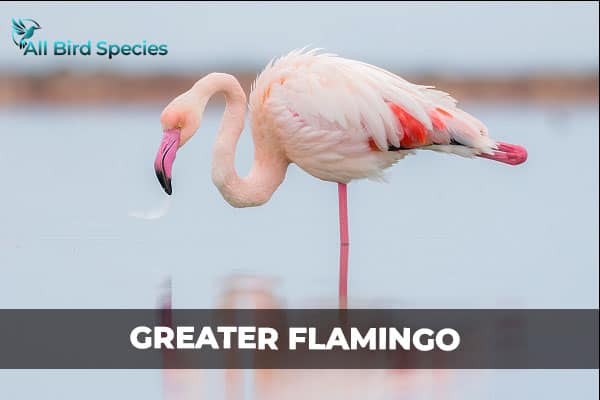
Flamingo Species and Their Habitats
There are three types of flamingos with six total species. The Greater Flamingo is the most common and lives in Africa, Europe, and Asia. The Lesser Flamingo is found from Africa to India, including the Great Rift Valley. The Chilean Flamingo lives in South America. James’s and Andean Flamingos make their home in the Andes. American or Caribbean Flamingos can be seen in the Caribbean, southern Florida, and parts of South America.
Unique Feeding Techniques
Flamingos eat in a special way. They use their feet to stir the water and their bills to catch tiny creatures. The tallest flamingo is the Greater Flamingo, reaching up to 4.7 feet. The shortest is the Lesser Flamingo at 2.6 feet. These birds can stand on one leg to stay warm, fly well, and eat by filtering water through their beaks.
Loons – Diving Birds with Webbed Feet
Loons are birds known for diving. They have webbed feet for swimming underwater. They are found in freshwater habitats like lakes. Here, they move with their strong legs and webbed feet. Each species of loon has its own special ways and features for living in the water.
Loon Species and Their Behaviors
Common Loons live in clear lakes in Canada and the northern U.S. They dive to find food. Sometimes, they poke their heads in the water while on the surface. This is to spot prey. Their feet are far back on their bodies. This helps them swim but makes walking on land hard. Pacific Loons are seen a lot off Oregon’s coast in spring and fall. Common Loons are also in Oregon but more on the coast and less in big lakes.
When Common Loons fly, they look heavy with their big feet hanging down. Their wings are narrow. They fly smoothly, with a short wingbeat. This makes them look very elegant. Baby Loons stay with the adults for a while. They sometimes ride on their backs, especially the very young ones. The adults are quite big, like a duck but with a longer body. They look different in the summer and the rest of the year. Juvenile Loons have markings that make them look not too different from adults, just a bit more patterned.
Common Loons catch fish without splashing. They are very quiet underwater. They have special calls and are found in faraway, quiet lakes. These lakes are in the northern U.S. and Canada. The Loons don’t like busy places. They spend winter on the coasts, closer to land, in sheltered places like bays and estuaries.
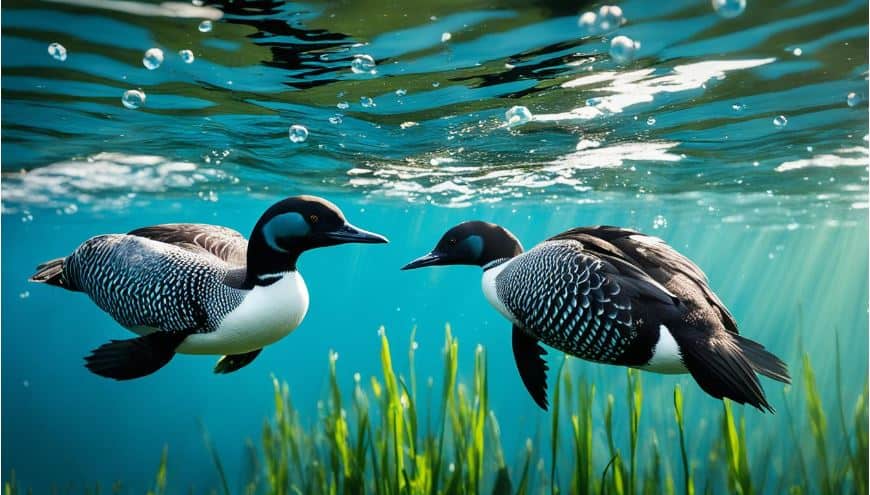
Penguins – Flightless Wonders with Webbed Feet
Penguins stand out among birds for not flying and their strong, webbed feet. They are part of the Spheniscidae family and eat meat. Their feet help them swim and dive well, making them skilled hunters in the water. These birds vary greatly in size, from 16 to 45 inches, and in weight from 2 to 88 pounds.
Penguin Species and Their Habitats
There are 18 penguin species known today, all living in the Southern Hemisphere mostly. They inhabit diverse places, from the cold Antarctic to the warmer shores of South America and Africa. These include the small blue penguin, about 10 to 12 inches long and 2.2 to 3.3 pounds, to the large emperor penguin, up to 45 inches tall and 88 pounds.
Adaptations for Underwater Survival
To live underwater, penguins have developed special abilities. They swim fast, up to 15 miles per hour, and some ‘toboggan’ over ice. Living in huge groups, from thousands to millions, they are still at risk. About two-thirds of penguin species are now threatened. Issues like too much fishing, climate change, and other environmental problems are hurting their numbers.
Common Terns – Graceful Aerial Hunters with Webbed Feet
Common terns are birds with webbed feet. They are known for their elegant flying and hunting skills. You can see these birds along coasts and near water bodies. Here, they dive with their webbed feet to catch small fish. They usually hunt for fish that are less than 7 inches long. These birds have a sleek body. They wear a distinctive black cap. These features help them move well in the air and water while hunting.
Common terns lay 1-4 eggs at a time. It takes these eggs about 22-27 days to hatch. The chicks stay in their nest for 20-31 days. Then, they learn to fly. There are about 2.8 million Common Terns around the world. Their numbers suggest they are not in immediate danger. This is good news for their conservation.
Populations of Common Terns in North America have been steady since 1966. Yet, things were not always so good. In the late 1800s, very few were left along the Atlantic Coast. This was because they were hunted for their feathers. Luckily, the Migratory Bird Treaty Act of 1918 helped them. By the 1930s, their numbers started to grow again.
Pelicans – Skilled Fishers with Webbed Feet

Pelicans are large birds with webbed feet that stand out. They’re well-known for their fishing skills. These birds live in many water areas, using their big, curved beaks and webbed feet to catch fish. Pelicans are great at diving and grabbing fish off the water. This makes them excellent hunters in their homes.
The brown pelican is the smallest of eight kinds. It’s about 48 inches long with an 84-inch wingspan. In the 1960s and early 1970s, these birds nearly disappeared from North America. This was because of losing their homes and pesticides. But they’ve come back since then., Nowadays, you often see brown pelicans on the coasts. They eat fish like menhaden and mullet.
These birds are some of the heaviest that can fly. The biggest ones weigh nearly 30 pounds. They are skilled at diving from high up, about 50 to 60 feet. They do this to catch fish., After they catch fish, they can get rid of about 2.5 gallons of water. This makes them good at fishing. Finding pelicans by the coast or on rivers can be very fun for people who love watching birds.


